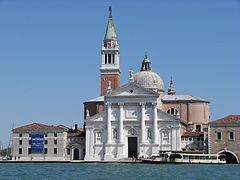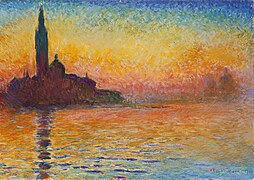
Vincenzo Scamozzi was an Italian architect and a writer on architecture, active mainly in Vicenza and Republic of Venice area in the second half of the 16th century. He was perhaps the most important figure there between Andrea Palladio, whose unfinished projects he inherited at Palladio's death in 1580, and Baldassarre Longhena, Scamozzi's only pupil.

The Chiesa del Santissimo Redentore, commonly known as Il Redentore, is a 16th-century Roman Catholic church located on Giudecca (island) in the sestiere of Dorsoduro, in the city of Venice, Italy.

The Chiesa di San Polo is a Catholic church in Venice, dedicated to the Apostle Paul. It gives its name to the San Polo sestiere of the city.

The Basilica dei Santi Giovanni e Paolo, known in Venetian as San Zanipolo, is a Catholic minor basilica and Dominican conventual church in the Castello sestiere of Venice, Italy.

San Giorgio Maggiore is one of the islands of Venice, northern Italy, lying east of the Giudecca and south of the main island group. The island, or more specifically its Palladian church, is an important landmark. It has been much painted, featuring for example in a series by Monet.

The Gallerie dell'Accademia is a museum gallery of pre-19th-century art in Venice, northern Italy. It is housed in the Scuola della Carità on the south bank of the Grand Canal, within the sestiere of Dorsoduro. It was originally the gallery of the Accademia di Belle Arti di Venezia, the art academy of Venice, from which it became independent in 1879, and for which the Ponte dell'Accademia and the Accademia boat landing station for the vaporetto water bus are named. The two institutions remained in the same building until 2004, when the art school moved to the Ospedale degli Incurabili.

The basilica diSan Pietro is a Catholic basilica and abbey in the Italian city of Perugia. Its bell tower, standing at 70 meters tall, is the tallest structure in Perugia and is one of the city's most significant symbols. It is an Italian national monument

Antonio Vassilacchi, also called L'Aliense, was a Greek painter, who was active mostly in Venice and the Veneto.

The San Giorgio Monastery is a Benedictine monastery in Venice, Italy, located on the island of San Giorgio Maggiore. It stands next to the Church of San Giorgio Maggiore, which serves the monastic community. Most of the old monastic buildings currently serve as headquarters of the Cini Foundation.

Santa Maria in Vallicella, also called Chiesa Nuova, is a church in Rome, Italy, which today faces onto the main thoroughfare of the Corso Vittorio Emanuele and the corner of Via della Chiesa Nuova. It is the principal church of the Oratorians, a religious congregation of secular priests, founded by St Philip Neri in 1561 at a time in the 16th century when the Counter Reformation saw the emergence of a number of new religious institutes such as the Jesuits, the Theatines, and the Barnabites. These new congregations were responsible for several great preaching churches built in the Centro Storico, the others being Sant'Andrea della Valle (Theatines), San Carlo ai Catinari (Barnabites), and The Gesù and Sant'Ignazio (Jesuits).

San Francesco della Vigna is a Roman Catholic church in the Sestiere of Castello in Venice, northern Italy.

The Madonna dell'Orto is a church in Venice, Italy, in the sestiere of Cannaregio. This was the home parish of Tintoretto and holds a number of his works as well as his tomb.

The Basilica of San Domenico, also known as Basilica Cateriniana, is a basilica church in Siena, Tuscany, Italy, one of the most important in the city. The basilica is an example of Cistercian Gothic style.

Santa Maria dei Carmini, also called Santa Maria del Carmelo and commonly known simply as the Carmini, is a large Roman Catholic church in the sestiere, or neighbourhood, of Dorsoduro in Venice, northern Italy. It nestles against the former Scuola Grande di Santa Maria del Carmelo, also known as the Scuola dei Carmini. This charitable confraternity was officially founded in 1597, and arose from a lay women's charitable association, the Pinzocchere dei Carmini. The members of this lay group were associated as tertiaries to the neighbouring Carmelite monastery. They were responsible for stitching the scapulars for the Carmelites.

The Basilica di San Pietro di Castello, commonly called San Pietro di Castello, is a Roman Catholic minor basilica of the Patriarch of Venice located in the Castello sestiere of the Italian city of Venice. The present building dates from the 16th century, but a church has stood on the site since at least the 7th century. From 1451 to 1807, it was the city's cathedral church, though hardly playing the usual dominant role of a cathedral, as it was overshadowed by the "state church" of San Marco and inconveniently located. During its history, the church has undergone a number of alterations and additions by some of Venice's most prominent architects. Andrea Palladio received his first commission in the city of Venice from the Patriarch Vincenzo Diedo to rebuild the facade and interior of St Pietro, but Diedo's death delayed the project.

San Giovanni Evangelista is a Mannerist-style, Roman Catholic church located on Piazzale San Giovanni, located just behind the apse of the Parma Cathedral, in the historic center of Parma, northern Italy. The buildings surrounding the piazza were also part of a former Benedictine convent. The church is notable for its Correggio frescoes.
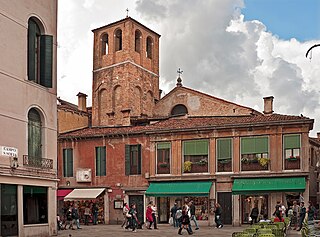
Santa Sofia is a church located in the sestiere (neighborhood) of Cannaregio in Venice, Italy. It should be distinguished from the palazzo Ca' d'Oro on the Grand Canal is also called the Palazzo Santa Sofia.
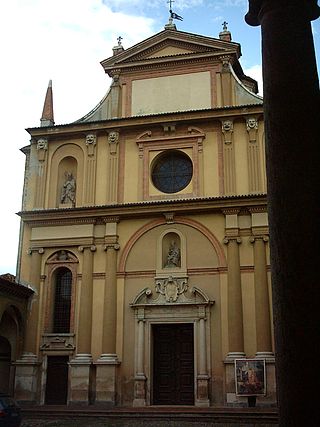
San Sisto is a Renaissance style, Roman Catholic church, located on the Via of the same name in north-central Piacenza, Region of Emilia Romagna, Italy.
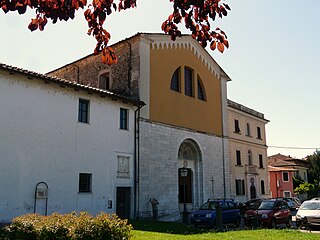
San Francesco is a Roman Catholic church and monastery located in Sarzana, region of Liguria, Italy.

Santa Maria in Vanzo is a Renaissance-style, Roman Catholic church in Padua, region of Veneto, Italy.




